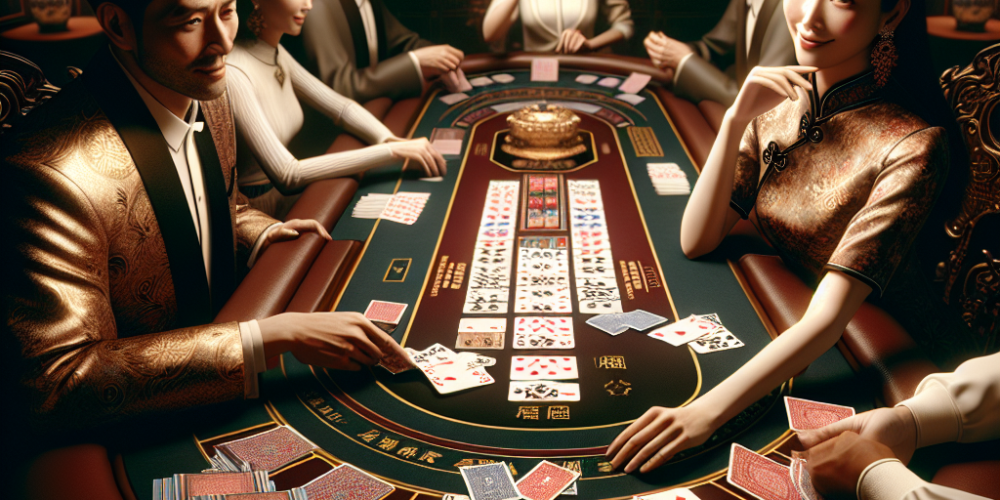Many Pai Gow Poker players often overlook the power of setting their hands optimally, focusing instead solely on the traditional poker aspect. This strategic misstep can cost games and diminish potential wins. Here, we delve into expert strategies that turn the tables in your favor, starting with robust hand-setting techniques, moving through bankroll management, and rounding off with interpersonal tactics at the table.
Mastering Hand Settings in Pai Gow Poker
Pai Gow Poker, a blend of ancient Chinese Pai Gow and classic American Poker, requires players to create two hands out of seven cards: a five-card high hand and a two-card low hand. The primary challenge is to balance these hands to outperform the dealer’s equivalent.
High Hand Heroics
Your five-card hand follows traditional poker rankings, so always aim for at least a straight or flush if the cards have potential. When dealt a full house, conventional wisdom suggests keeping the three-of-a-kind in the high hand and using the pair in the low hand. This split maximizes the strength of both hands rather than over-focusing on one.
Low Hand Leveraging
For your two-card hand, pairs often lead the way. However, if you’re devoid of pairs but flush with high cards (like a King and an Ace), these should go into your low hand. This arrangement guards against losing by slight margins, which happens often if the low hand is too weak compared to the high hand.
Strategic Play Decisions
In Pai Gow Poker, the way you manage your hand can significantly influence the game’s outcome. Recognizing when to play aggressively and when to defend can be the difference between a win and a loss.
Handling Full Houses
While the standard strategy with a full house is splitting it up, consider keeping it intact if you have a second pair to use in your low hand. This tactic can be formidable, especially if the dealer shows signs of a weak hand.
Utilizing Jokers
The joker in Pai Gow acts as a semi-wild card. It can be any ace or complete a straight or a flush. Strategic placement of the joker can turn a losing hand into a winning setup. Always consider the joker as a way to strengthen your weaker hand without sacrificing the potential of the stronger hand.
Bankroll Management in Pai Gow Poker
Pai Gow Poker is known for its slow pace and frequent pushes, which means it’s easier to play longer with a smaller bankroll compared to other casino games.
Setting Win/Loss Limits
Decide on a clear maximum loss and a specific win goal for each session. For instance, start with a bankroll of $200, set a loss limit of $50, and a win goal of $100. Once you reach either threshold, take a break and assess whether to continue playing.
Choosing the Right Table
Opt for tables with minimum bets that are no more than 1/20th of your total bankroll. This strategy ensures you can endure the inherent swings in the game without depleting your funds too rapidly.
Interpersonal Dynamics at the Table
Pai Gow Poker is typically a more relaxed environment compared to other high-stakes games. Use this to your advantage by engaging with the dealer and observing other players’ hand-setting patterns without revealing your strategies.
Reading the Dealer and Opponents
Watch for consistent weaknesses in how the dealer sets their hands. Most follow a set house way, which you can predict and counteract once recognized. Similarly, less experienced players might reveal hesitations or patterns that you can anticipate for future rounds.
Table Etiquette and Interaction
Being friendly and respectful can make the gaming experience more enjoyable and keep the game flowing smoothly. It also makes it less likely for others to rigorously scrutinize your play, allowing you more psychological comfort to focus on your strategy.
In conclusion, Pai Gow Poker is not just about understanding the rank of poker hands but also about strategic hand setting, managing your bankroll wisely, and interacting beneficially with others at the table. By mastering these aspects, you put yourself in a strong position to maximize your enjoyment and profitability in Pai Gow Poker. Remember, the goal is to balance risk and reward effectively while ensuring that you remain in control of your playing decisions and finances.

















